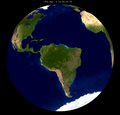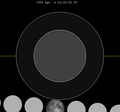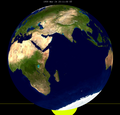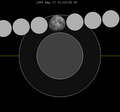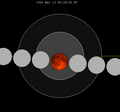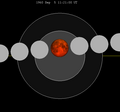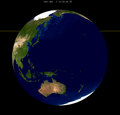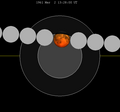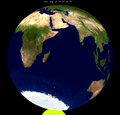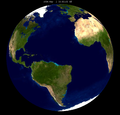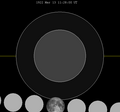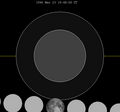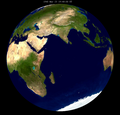Top Qs
Timeline
Chat
Perspective
April 1958 lunar eclipse
Penumbral lunar eclipse April 4, 1958 From Wikipedia, the free encyclopedia
Remove ads
A penumbral lunar eclipse occurred at the Moon’s ascending node of orbit on Friday, April 4, 1958,[1] with an umbral magnitude of −0.9421. A lunar eclipse occurs when the Moon moves into the Earth's shadow, causing the Moon to be darkened. A penumbral lunar eclipse occurs when part or all of the Moon's near side passes into the Earth's penumbra. Unlike a solar eclipse, which can only be viewed from a relatively small area of the world, a lunar eclipse may be viewed from anywhere on the night side of Earth. Occurring only about 16.5 hours before perigee (on April 3, 1958, at 20:30 UTC), the Moon's apparent diameter was larger.[2]
This was the last penumbral lunar eclipse in Lunar Saros 102. In this extremely marginal eclipse, the Moon barely clipped the edge of the Earth's penumbral shadow. This caused a microscopic darkening of just 1% of the Moon's disc for about 31 minutes, which was essentially impossible to see.
Remove ads
Visibility
The eclipse was completely visible over North America, South America, most of Africa and western Europe.[3]
  |
Eclipse details
Shown below is a table displaying details about this particular lunar eclipse. It describes various parameters pertaining to this eclipse.[4]
Remove ads
Eclipse season
This eclipse is part of an eclipse season, a period, roughly every six months, when eclipses occur. Only two (or occasionally three) eclipse seasons occur each year, and each season lasts about 35 days and repeats just short of six months (173 days) later; thus two full eclipse seasons always occur each year. Either two or three eclipses happen each eclipse season. In the sequence below, each eclipse is separated by a fortnight. The first and last eclipse in this sequence is separated by one synodic month.
Related eclipses
Summarize
Perspective
Eclipses in 1958
- A penumbral lunar eclipse on April 4.
- An annular solar eclipse on April 19.
- A partial lunar eclipse on May 3.
- A total solar eclipse on October 12.
- A penumbral lunar eclipse on October 27.
Tzolkinex
- Preceded by: Lunar eclipse of February 21, 1951
Lunar Saros 102
- Preceded by: Lunar eclipse of March 23, 1940
Lunar eclipses of 1958–1962
This eclipse is a member of a semester series. An eclipse in a semester series of lunar eclipses repeats approximately every 177 days and 4 hours (a semester) at alternating nodes of the Moon's orbit.[5]
The lunar eclipses on May 3, 1958 (partial) and October 28, 1958 (penumbral) occur in the previous lunar year eclipse set, and the penumbral lunar eclipse on July 17, 1962 occurs in the next lunar year eclipse set.
Saros 102
This eclipse is a part of Saros series 102, repeating every 18 years, 11 days, and containing 84 events. The series started with a penumbral lunar eclipse on October 5, 461 AD. It contains partial eclipses from May 20, 840, through July 13, 930; total eclipses from July 23, 948, through April 20, 1399; and a second set of partial eclipses from May 1, 1417, through July 16, 1543. The series ends at member 84 as a penumbral eclipse on April 4, 1958.
The longest duration of totality was produced by member 36 at 104 minutes, 43 seconds, on October 7, 1074. All eclipses in this series occur at the Moon’s ascending node of orbit.[6]
Eclipses are tabulated in three columns; every third eclipse in the same column is one exeligmos apart, so they all cast shadows over approximately the same parts of the Earth.
Remove ads
See also
Notes
External links
Wikiwand - on
Seamless Wikipedia browsing. On steroids.
Remove ads




